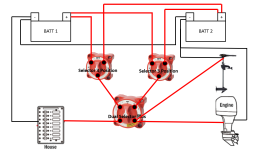Christopher D Terpening
Cadet
- Joined
- Feb 22, 2018
- Messages
- 6
I was hoping to get some feedback on my boat wiring plans (see attached diagram). I have two dual purpose group 31 batteries. These will be powering my accessories (primarily fish finders) as well as starting the motor and running the trolling motor. I want to be able to have two isolated circuits. Circuit 1: Fish finders and all other accessories. Circuit 2: Outboard and Trolling motor. Additionally, I would like to be able to switch which battery each circuit is drawing from. For example, if the trolling motor draws Battery 1 low, I would like to be able to switch it over to Battery 2, then switch the accessories over to Battery 1. The primary reason for this setup is that I want to keep the fish finders on a separate circuit from the trolling motor and outboard in order to avoid any interference. This setup also gives me full flexibility in choosing which battery powers which circuit, and also gives me the ability to run everything from both batteries simultaneously if desired.
Will the combination of switches and circuit depicted give me what I am looking for?
Are there any potential issues wiring this way? For example, what happens if both 3 position switches are positioned to Battery 1, and the Dual Selector Switch is positioned to “Combine Batteries”? Not that I plan on doing that, just want to make sure there are no dangerous combinations.
Does the common ground between negative battery terminals introduce the possibility of interference across circuits (e.g. trolling motor interfering with fish finder)?
Thanks in advance for your help!
Will the combination of switches and circuit depicted give me what I am looking for?
Are there any potential issues wiring this way? For example, what happens if both 3 position switches are positioned to Battery 1, and the Dual Selector Switch is positioned to “Combine Batteries”? Not that I plan on doing that, just want to make sure there are no dangerous combinations.
Does the common ground between negative battery terminals introduce the possibility of interference across circuits (e.g. trolling motor interfering with fish finder)?
Thanks in advance for your help!





















